seats CHEVROLET S10 2003 2.G Owners Manual
[x] Cancel search | Manufacturer: CHEVROLET, Model Year: 2003, Model line: S10, Model: CHEVROLET S10 2003 2.GPages: 432, PDF Size: 2.82 MB
Page 1 of 432

Seats and Restraint Systems........................... 1-1
Front Seats
............................................... 1-3
Rear Seats
............................................... 1-9
Safety Belts
.............................................1-10
Child Restraints
.......................................1-30
Air Bag System
.......................................1-55
Restraint System Check
............................1-65
Features and Controls..................................... 2-1
Keys
........................................................ 2-3
Doors and Locks
....................................... 2-8
Windows
.................................................2-14
Theft-Deterrent Systems
............................2-17
Starting and Operating Your Vehicle
...........2-19
Mirrors
....................................................2-39
Storage Areas
.........................................2-41
Sunroof
..................................................2-51
Vehicle Personalization
.............................2-53
Instrument Panel............................................. 3-1
Instrument Panel Overview
.......................... 3-2
Climate Controls
......................................3-18
Warning Lights, Gages and Indicators
.........3-22
Audio System(s)
.......................................3-40
Driving Your Vehicle....................................... 4-1
Your Driving, the Road, and Your Vehicle
..... 4-2
Towing
...................................................4-44Service and Appearance Care.......................... 5-1
Service
..................................................... 5-3
Fuel
......................................................... 5-4
Checking Things Under
the Hood
.............................................5-10
Rear Axle
...............................................5-51
Four-Wheel Drive
.....................................5-52
Front Axle
...............................................5-53
Bulb Replacement
....................................5-54
Windshield Wiper Blade Replacement
.........5-60
Tires
......................................................5-62
Appearance Care
.....................................5-83
Vehicle Identi®cation
.................................5-92
Electrical System
......................................5-93
Capacities and Speci®cations
.....................5-99
Normal Maintenance Replacement Parts
....5-101
Maintenance Schedule..................................... 6-1
Maintenance Schedule
................................ 6-2
Customer Assistance Information.................... 7-1
Customer Assistance Information
.................. 7-2
Reporting Safety Defects
............................ 7-9
Index................................................................ 1
2003 Chevrolet S10 Pickup Owner ManualM
Page 4 of 432

Vehicle Damage Warnings
Also, in this book you will ®nd these notices:
Notice:These mean there is something that could
damage your vehicle.
A notice will tell you about something that can damage
your vehicle. Many times, this damage would not be
covered by your warranty, and it could be costly. But the
notice will tell you what to do to help avoid the
damage.
When you read other manuals, you might see CAUTION
and NOTICE warnings in different colors or in different
words.
You'll also see warning labels on your vehicle. They use
the same words, CAUTION or NOTICE.
Vehicle Symbols
Your vehicle has components and labels that use
symbols instead of text. Symbols, used on your vehicle,
are shown along with the text describing the operation
or information relating to a speci®c component, control,
message, gage or indicator.
If you need help ®guring out a speci®c name of a
component, gage or indicator, reference the following
topics:
·Seats and Restraint Systems in Section 1
·Features and Controls in Section 2
·Instrument Panel Overview in Section 3
·Climate Controls in Section 3
·Warning Lights, Gages and Indicators in Section 3
·Audio System(s) in Section 3
·Engine Compartment Overview in Section 5
iv
Page 7 of 432

Front Seats......................................................1-3
Manual Seats................................................1-3
Power Seats..................................................1-4
Manual Lumbar..............................................1-4
Power Lumbar...............................................1-5
Heated Seats.................................................1-5
Reclining Seatbacks........................................1-6
Head Restraints.............................................1-7
Seatback Latches...........................................1-8
Rear Seats.......................................................1-9
Rear Seat Operation.......................................1-9
Jump Seat...................................................1-10
Safety Belts...................................................1-10
Safety Belts: They Are for Everyone................1-10
Questions and Answers About Safety Belts......1-15
How to Wear Safety Belts Properly.................1-16
Driver Position..............................................1-16
Safety Belt Use During Pregnancy..................1-22
Right Front Passenger Position.......................1-23
Center Passenger Position.............................1-23
Rear Seat Passengers (Extended Cab
Jump Seat)..............................................1-25Rear Seat Passengers (Crew Cabž) ................1-26
Safety Belt Extender.....................................1-29
Child Restraints.............................................1-30
Older Children..............................................1-30
Infants and Young Children............................1-32
Child Restraint Systems.................................1-36
Where to Put the Restraint (Regular Cab and
Extended Cab Pickup)...............................1-39
Where to Put the Restraint
(Crew Cab
žPickup)...................................1-40
Top Strap....................................................1-41
Top Strap Anchor Location.............................1-43
Lower Anchorages and Top Tethers for
Children (LATCH System)...........................1-44
Securing a Child Restraint Designed for the
LATCH System.........................................1-46
Securing a Child Restraint in a Rear Outside
Seat Position............................................1-46
Securing a Child Restraint in a Center Seat
Position...................................................1-49
Securing a Child Restraint in the Right Front
Seat Position............................................1-49
Section 1 Seats and Restraint Systems
1-1
Page 8 of 432

Air Bag System..............................................1-55
Where Are the Air Bags?...............................1-57
When Should an Air Bag In¯ate?....................1-59
What Makes an Air Bag In¯ate?.....................1-59
How Does an Air Bag Restrain?.....................1-59
What Will You See After an Air Bag In¯ates? . . .1-60
Air Bag Off Switch........................................1-61Servicing Your Air Bag-Equipped Vehicle.........1-64
Adding Equipment to Your Air Bag-Equipped
Vehicle....................................................1-65
Restraint System Check..................................1-65
Checking Your Restraint Systems...................1-65
Replacing Restraint System Parts After a
Crash......................................................1-66
Section 1 Seats and Restraint Systems
1-2
Page 9 of 432
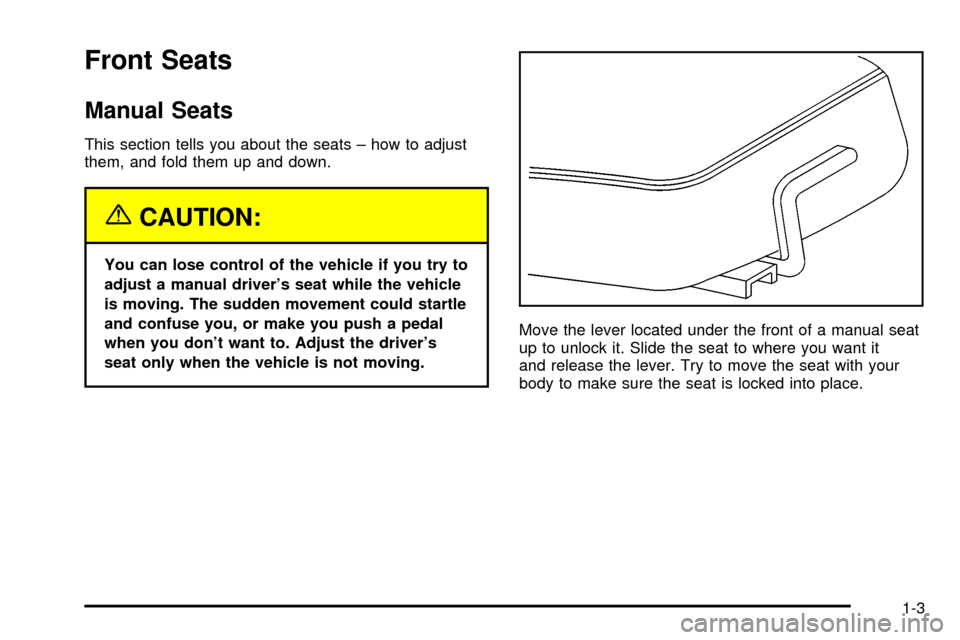
Front Seats
Manual Seats
This section tells you about the seats ± how to adjust
them, and fold them up and down.
{CAUTION:
You can lose control of the vehicle if you try to
adjust a manual driver's seat while the vehicle
is moving. The sudden movement could startle
and confuse you, or make you push a pedal
when you don't want to. Adjust the driver's
seat only when the vehicle is not moving.Move the lever located under the front of a manual seat
up to unlock it. Slide the seat to where you want it
and release the lever. Try to move the seat with your
body to make sure the seat is locked into place.
1-3
Page 10 of 432

Power Seats
If your vehicle has this feature, there will be a control on
the outboard side of the front seat(s).
Horizontal Control:Raise or lower the front of the seat
by raising or lowering the forward edge of the control.
Raise or lower the rear of the seat by raising or lowering
the rear edge of the control. Move the seat forward or
rearward by moving the whole control toward the front or
the rear of the vehicle.Moving the whole control up or down raises or lowers
the whole seat.
Vertical Control:Move the reclining front seatback
forward or rearward by moving the control toward
the front or rear of the vehicle.
Manual Lumbar
If your vehicle has this
feature, there will be a
knob located on the
outboard side of the
driver's seat.
Turn the knob counterclockwise to increase lumbar
support and clockwise to decrease lumbar support.
1-4
Page 11 of 432
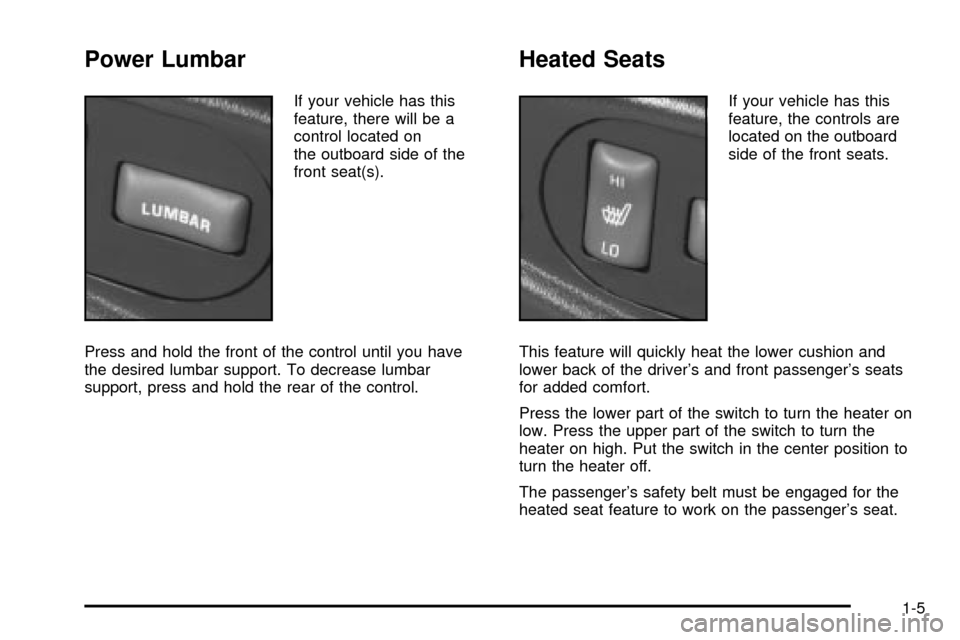
Power Lumbar
If your vehicle has this
feature, there will be a
control located on
the outboard side of the
front seat(s).
Press and hold the front of the control until you have
the desired lumbar support. To decrease lumbar
support, press and hold the rear of the control.
Heated Seats
If your vehicle has this
feature, the controls are
located on the outboard
side of the front seats.
This feature will quickly heat the lower cushion and
lower back of the driver's and front passenger's seats
for added comfort.
Press the lower part of the switch to turn the heater on
low. Press the upper part of the switch to turn the
heater on high. Put the switch in the center position to
turn the heater off.
The passenger's safety belt must be engaged for the
heated seat feature to work on the passenger's seat.
1-5
Page 12 of 432
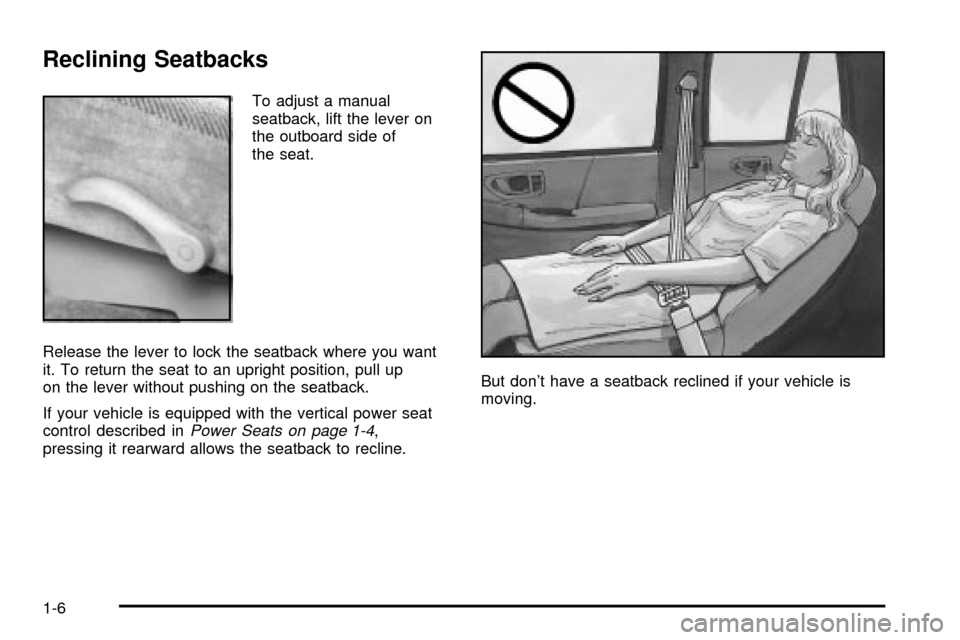
Reclining Seatbacks
To adjust a manual
seatback, lift the lever on
the outboard side of
the seat.
Release the lever to lock the seatback where you want
it. To return the seat to an upright position, pull up
on the lever without pushing on the seatback.
If your vehicle is equipped with the vertical power seat
control described in
Power Seats on page 1-4,
pressing it rearward allows the seatback to recline.But don't have a seatback reclined if your vehicle is
moving.
1-6
Page 15 of 432
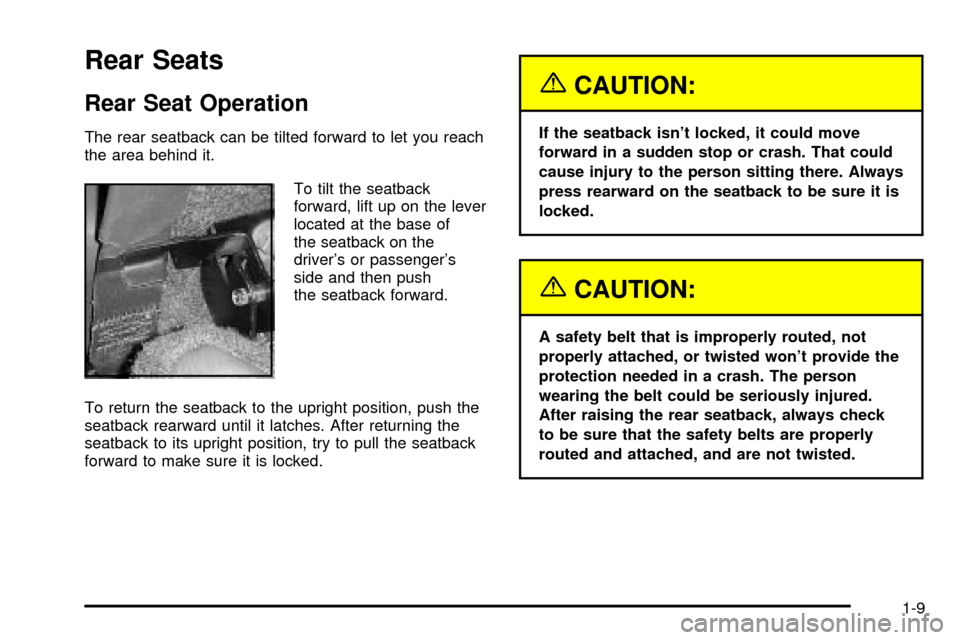
Rear Seats
Rear Seat Operation
The rear seatback can be tilted forward to let you reach
the area behind it.
To tilt the seatback
forward, lift up on the lever
located at the base of
the seatback on the
driver's or passenger's
side and then push
the seatback forward.
To return the seatback to the upright position, push the
seatback rearward until it latches. After returning the
seatback to its upright position, try to pull the seatback
forward to make sure it is locked.
{CAUTION:
If the seatback isn't locked, it could move
forward in a sudden stop or crash. That could
cause injury to the person sitting there. Always
press rearward on the seatback to be sure it is
locked.
{CAUTION:
A safety belt that is improperly routed, not
properly attached, or twisted won't provide the
protection needed in a crash. The person
wearing the belt could be seriously injured.
After raising the rear seatback, always check
to be sure that the safety belts are properly
routed and attached, and are not twisted.
1-9
Page 17 of 432
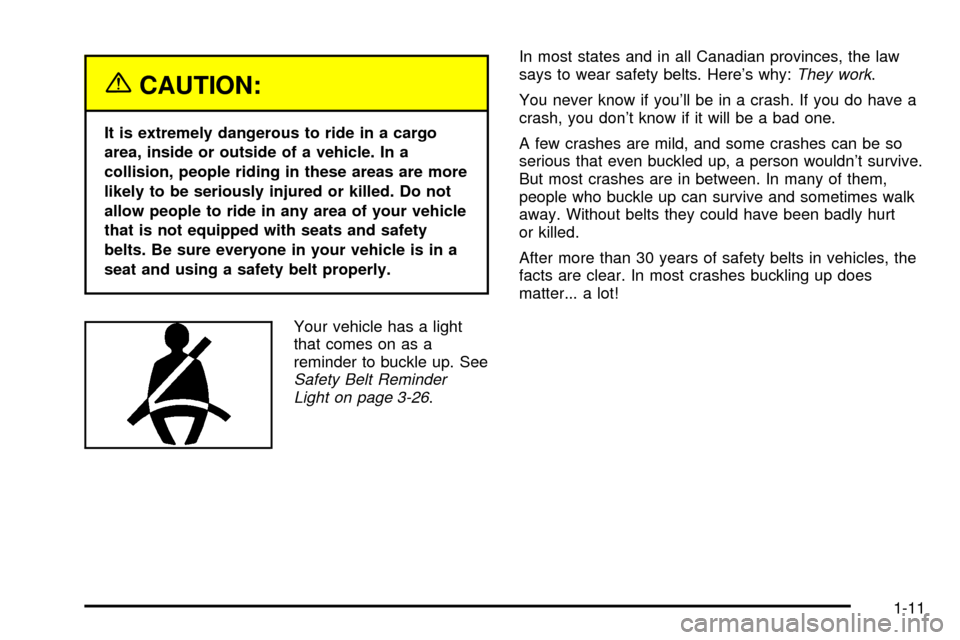
{CAUTION:
It is extremely dangerous to ride in a cargo
area, inside or outside of a vehicle. In a
collision, people riding in these areas are more
likely to be seriously injured or killed. Do not
allow people to ride in any area of your vehicle
that is not equipped with seats and safety
belts. Be sure everyone in your vehicle is in a
seat and using a safety belt properly.
Your vehicle has a light
that comes on as a
reminder to buckle up. See
Safety Belt Reminder
Light on page 3-26.In most states and in all Canadian provinces, the law
says to wear safety belts. Here's why:
They work.
You never know if you'll be in a crash. If you do have a
crash, you don't know if it will be a bad one.
A few crashes are mild, and some crashes can be so
serious that even buckled up, a person wouldn't survive.
But most crashes are in between. In many of them,
people who buckle up can survive and sometimes walk
away. Without belts they could have been badly hurt
or killed.
After more than 30 years of safety belts in vehicles, the
facts are clear. In most crashes buckling up does
matter... a lot!
1-11